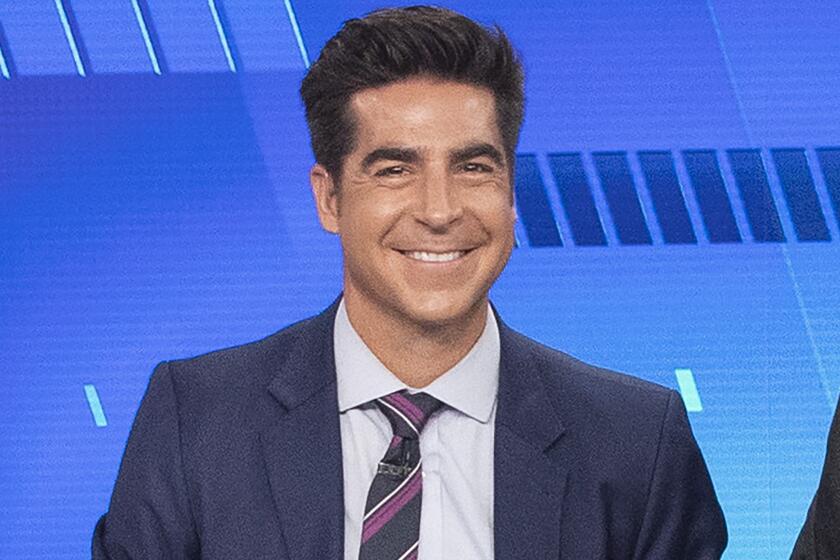What Stephen Colbert’s cancellation says about the future of TV

- Share via
Last week’s cancellation of “The Late Show with Stephen Colbert” was an earthquake felt by every Jimmy, John and Seth in the TV business.
On Thursday, Colbert shocked his studio audience, social media and Hollywood with the news that the long-running late night talk show will end in May. Colbert, who has hosted “The Late Show” since taking over from David Letterman 10 years ago, will not be replaced. The franchise that has long led its direct broadcast competition will be no more.
Commentators immediately rushed to interpret the broader meaning of the decision. At best, it was seen as the latest sign that the entire genre of late night talk programming — a bedrock of broadcasting since the 1950s — is doomed, along with the rest of entertainment programming on linear TV other than sports and live events. Others floated more nefarious explanations.
You didn’t have to be an Epstein files conspiracy theorist to wonder if there were political motivations behind the move. Only days before the announcement, Colbert had slammed his parent company, Paramount Global, for paying $16 million to settle Trump’s lawsuit over CBS News’ edits to a “60 Minutes” Kamala Harris interview — a legal salvo that experts had called frivolous.
He described the settlement as a “big fat bribe,” referencing the fact that Paramount is desperately awaiting Federal Communications Commission approval, under Trump-appointed Chairman Brendan Carr, for its long-pending $8-billion merger with David Ellison’s Skydance Media. Colbert learned of the cancellation decision Wednesday and informed his audience on Thursday.
To quote another classic Paramount property, “The Naked Gun,” which is being rebooted: “Please disperse. Nothing to see here.” The Writers Guild of America swiftly weighed in, calling for an investigation and warning that the beleaguered company was “sacrificing free speech to curry favor with the Trump Administration.” Sens. Adam Schiff (D-Calif.) and Elizabeth Warren (D-Mass.) raised similar concerns.
Paramount co-Chief Executive George Cheeks and CBS leaders Amy Reisenbach and David Stapf said in a statement last week that shuttering “The Late Show” was “purely a financial decision against a challenging backdrop in late night,” and had nothing to do with the show’s performance or anything going on at Paramount.
Keith Olbermann, never one to accept corporate spin at face value, raised an interesting point. “Yes, I get this is heresy,” he wrote on X. “But, no, CBS didn’t cancel Colbert primarily to appease Trump. One incontrovertible fact confirms this: you silence him by … keeping him on TV as an uncontrollable lame duck for 10 months?”
Indeed, Colbert was back on the air Monday night taking Trump to task. “Go f— yourself,” Colbert said to the camera at one point in reference to the president.
Jon Stewart’s reaction did not disappoint on Comedy Central’s “The Daily Show,” where he delivered a searing, f-bomb-filled monologue against his network’s parent company. “I don’t think the answer can be found in some smoking gun email,” Stewart said of “The Late Show’s” demise. “I think the answer is in the fear and pre-compliance that is gripping all of American institutions at this very moment.”
Notably, Colbert rose to fame on “The Daily Show,” reporting in character as an over-the-top conservative commentator before launching “The Colbert Report” on Comedy Central. (This episode, incidentally, also featured an interview with Los Angeles Times owner Patrick Soon-Shiong, who disclosed that he plans to take the paper public in the next year.)
Paramount’s explanation holds some water for one simple reason: The business of late night talk is in decline. Ratings and ad revenue are down, and with highly paid hosts, these shows are not cheap.
Colbert remains the biggest draw in his time slot, averaging 1.9 million viewers, according to Nielsen, but he commands the largest slice of a shrinking pie. As my colleague Stephen Battaglio reported, “The Late Show” is said to be losing tens of millions of dollars a year as younger viewers flee. Since 2022, the show has lost 20% of its audience in the advertiser-coveted 18-to-49 age group, according to Nielsen.
Ad revenue for “The Late Show” in 2024 was $57.7 million, according to iSpot.tv, down from $75.7 million in 2022. NBC’s “The Tonight Show Starring Jimmy Fallon” and ABC’s “Jimmy Kimmel Live!” have also slipped. As a result, late night shows have been slashing costs. NBC cut Fallon’s show to four nights a week last year, while “Late Night With Seth Meyers” eliminated its live band. Two years ago, CBS canceled “The Late Late Show” hosted by James Corden.
One problem: Late night shows no longer serve the role they once did — especially for generations that grew up with social media and don’t subscribe to TV packages. Waiting until 11:30 p.m. to hear the hot takes on the day’s news is antiquated when political satire and commentary are now freely available and on demand through podcasts, TikTok, YouTube and X.
Celebrities have ways to promote their movies other than by hitting the desk-and-couch interview circuit. And if the goal is to give viewers a few chuckles before bed, there are endless Instagram accounts to choose from. The late night hosts’ focus on Trump as comedic fodder surely narrowed their appeal over time as well. Over on Fox News, “Gutfeld!” draws about 3 million viewers a night.
Networks have tried to adapt by chopping up their shows into clips for online consumption, but that strategy doesn’t bring in the same advertising revenue, and it gives audiences even less reason to watch the full broadcast later.
Analyst Rich Greenfield, writing in a LightShed Partners blog post, said Colbert’s impending departure is just the “tip of the iceberg.”
“While there is shock and awe to the cancellation of ‘The Late Show’ on CBS, the real question is: why is any legacy media company still investing in original programming for linear TV outside of sports and news?” he wrote.
One thing remains certain: Even if Ellison had no part in “The Late Show’s” cancellation, his deal to take over the company looms large over management’s decisions. Ellison and RedBird are expected to continue slashing costs as linear TV erodes and the film business settles into its new normal post-COVID.
The company has been deep in negotiations with “South Park” creators Matt Stone and Trey Parker over their rich overall deal and streaming rights for the show.
On Monday, The Times reported that Paramount had reached a deal with the “South Park” guys that values the show’s streaming rights at about $1.5 billion over five years.
Ellison’s team had been reluctant to overpay for a series now entering its 27th season, which led to tensions. That may foreshadow how Ellison will approach relationships with the company’s top talent. Expect Paramount to continue trimming traditional TV programming in favor of its streaming service, Paramount+.
The typical weekday late night format has never truly worked on subscription-based platforms, though Netflix’s more experimental “Everybody’s Live with John Mulaney” has its fans. Somebody, somewhere, will eventually figure it out.
As with most things in Hollywood these days, streaming will have the last laugh.
You’re reading the Wide Shot
Ryan Faughnder delivers the latest news, analysis and insights on everything from streaming wars to production — and what it all means for the future.
You may occasionally receive promotional content from the Los Angeles Times.
Stuff we wrote
Number of the week

Netflix kept on winning. The streamer last week reported quarterly revenue that rose 16% to $11.1 billion, while the company’s net income increased 46% to $3.1 billion compared with a year earlier, beating Wall Street expectations.
The strong quarter was due to a robust lineup of shows (including Season 3 of “Squid Game”), price hikes and increased advertising sales. The Los Gatos, Calif.-based company raised its full-year guidance.
In terms of viewership, Netflix is on a solid run. In June, the service accounted for 8.3% of total TV usage, according to Nielsen, its greatest share since January. It was the third most-watched distributor of the month for the first time, coming in behind Disney (10%) and a still-growing YouTube (12.8%).
Netflix viewership rose 13.5% compared with May, thanks to popular new shows and an influx of young viewers on summer break. Engagement is critical for Netflix. More time spent watching means fewer cancellations and increased appeal for advertisers.
The company’s lineup for the rest of the year has a number of highlights, including “Wednesday” Season 2, “Stranger Things” Season 5 and Christmas Day NFL games.

Peacock is getting more expensive.
Beginning July 23, NBCUniversal’s Peacock Premium will cost $10.99 a month, up $3 from the current $7.99 fee. The Premium Plus option will jump to $16.99 a month, up from $13.99.
Customers can pay $109.99 for an annual plan of Peacock Premium, or $169.99 a year for its Premium Plus option.
NBCUniversal is joining rivals by hiking prices in order to reach profitability. The company needs to show streaming profits as it prepares to spin off its mature but still money-making cable TV networks.
Finally ...
Watch: I’m enjoying Lena Dunham’s “Too Much,” starring Megan Stalter of “Hacks.” Here’s Robert Lloyd’s review.
Read: The Biggest K-Pop Band to Top the Charts Isn’t Even Real.
Also: Bros, Budweisers, and Divorced Dads: Butt Rock Is Back, Baby
Listen: Tyler the Creator — “Stop Playing With Me.”
Listen: Drain — “Stealing Happiness From Tomorrow.”
Inside the business of entertainment
The Wide Shot brings you news, analysis and insights on everything from streaming wars to production — and what it all means for the future.
You may occasionally receive promotional content from the Los Angeles Times.












